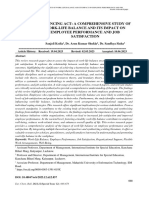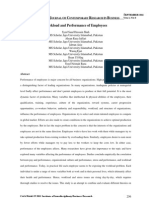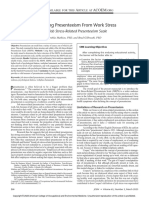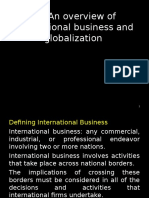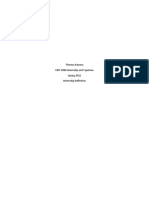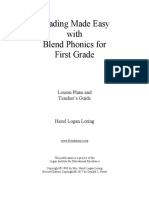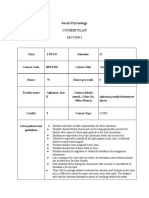Human Factors & Ergonomics in Organizational Design and Management
Uploaded by
AsadvirkHuman Factors & Ergonomics in Organizational Design and Management
Uploaded by
AsadvirkHuman Factors
& Ergonomics
in
Organizational
Design and
Management
Research Proposal
TABLE OF CONTENTS
INTRODUCTION 3
OBJECTIVE OF STUDY 3
SIGNIFICANCE OF STUDY 3
LITERATURE REVIEW 4
RATIONALE 6
RESEARCH QUESTION 6
RESEARCH DESIGN 7
Introduction
The study is being conducted to evaluate the significance of ergonomics in job design and its
impact on the reduction of employee stress levels. Certainly, one of the core objectives of the
management is to have their employees increased productivity because this helps the
organization be more effective and efficient. This can only be achieved in an ergonomically well
designed environment which should not overstress the employees. Ergonomics was previously
perceived to be only concerned with physical health and safety of employees. A different
dimension, however, relates it to the stress faced by employees and its psychological outcomes.
Ergonomics, therefore, should be a ey factor in organizational design and management. The
modern definition of ergonomics embeds it into the very core of job design. !t is indeed fitting
the job to the worer both physically and psychologically.
Objective of study
The purpose of this study is to evaluate the relationship among ergonomics and job stress. "e
propose to identify different variables in ergonomic job design and ergonomic distress and build
a relationship between them. #tress cannot be covered in a single study, which has to be carried
by a lone researcher within the limitations of time and resources.
Significance of study
This study is designed to help the organizations realize the importance of ergonomics from the
perspective of employee stress levels. $usiness performance is dependent upon ergonomically
designed worplace hence maing it a ey factor in organizational design and management. %nly
then they can improve the productivity and retention level of their employees. %rganizations
today need to now and reduce the impact of factors that contribute to the employees degree of
wor and stress. The study will assist the management to now, how the job design is affecting
the outcome of their employees and how to get ma&imum satisfaction and efficiency in
employees after solving the associated ergonomic problems.
Literature Review
Ergonomics 'or human factors( is the scientific discipline concerned with the understanding of
interaction among humans and other elements of system, and the profession that applies theory,
principles, data and methods to design in order to optimize human well)being and overall system
performance '!nternational Ergonomics Association(.Ergonomics is concerned designing and
shaping jobs as per physical abilities and characteristics of individuals so that they perform their
job effectively.
The ergonomics or human factor societies have been established the superior approaches for the
changing worplaces.
A discipline which deals with fundamentals understanding of human behaviour in purposeful
interacting of socio)technical systems and application of understanding to job design in real
setting'*ohn +. "ilson,,---(. .aul /.. 0eow 1 +abindernath #en ',--2( studied ergonomics in
manual component insertion and concluded that there is significant increase in revenue and profit
when ergonomics was applied to production.
+ose ',--3( e&amined that over woring hours in wor environment reduces the willingness of
employees to perform better jobs. "ith the increasing level of wor intensity, the employees
efficiency decreases which causes less or poor 4uality wor. Thadan ',--5( wor load increases
due to large duties and additional wor given by management which leads worers towards
stress. 6ing 1 .hilips ',--2( considered increased woring hours a cause of wor stress and low
job performance.
Ergonomics helps to design tass and jobs to mae them compatible with the needs and abilities
and limitations of worers '"aldemar 7arowsi(. The environmental conditions lie heat, noise,
smell and humidity influence employees to demonstrate low level of job performance and
increased stress 'Emin 7ahya, ,--5(.
8anufacturing managers need to build up an understanding of interrelations between ergonomics
distress and negative indicators such as poor production 4uality and increased sic leave. This
understanding can be seen as a major condition in order to identify poorly designed worplaces
and start measures that improve woring conditions '*ohnson, 9::;(
ob stress
*ob stress is <the harmful physical and emotional responses that occur when the re4uirements of
the job do not match the capabilities, resources, or needs of the worer= '>ational !nstitute for
%ccupational #afety and /ealth, 9:::(.
*ob stress is conceptualized as a condition where job related factors interact with the individual
to change his or her psychological or physiological conditions such that the person is forced to
deviate from normal functioning '$eehr 1 >ewman, 9:5;(. +ose ',--3( studied the results that
the stress in wor environment reduces the intention of employees to perform better in jobs with
the increasing level of stress the employees thining demoralize and his tendency to wor well
also decreases. $eehr '9::?( defined job stress as <a situation in which some characteristics of
the wor situation are thought to cause poor psychological or physical health, or to cause ris
factors maing poor health more liely.= #tress is acnowledged to be one of the main causes of
absence from wor '8ead, ,---(. Absenteeism has been defined as <non)attendance when an
employee is scheduled to wor@@ '.rice 1 8ueller, 9:;2(.
"or overloads and time constraints were significant contributors to wor stress among
community nurses '"iles, 9::;(. "orload stress can be defined as reluctance to come to wor
and a feeling of constant pressure 'i.e. no effort is enough( accompanied by the general
physiological, psychological, and behavioral stress symptoms 'Aivision of /uman +esource,
,---(. Al)Aameri ',--3( has mentioned in his studies that one of the si& factors of occupational
stress is pressure originating from worload.
+apidly changing global scene is increasing the pressure of worforce to perform ma&imum
output and enhance competitiveness. !ndeed, to perform better to their job, there is a re4uirement
for worers to perform multiple tass in the worplace to eep abreast of changing technologies
'Cascio, 9::?B Cuic, 9::5(. The ultimate results of this pressure have been found to one of the
important factors influencing job stress in their wor 'Cahn, ,---(. A study in D7 indicated that
the majority of the worers were unhappy with the current culture where they were re4uired to
wor e&tended hours and cope with large worloads while simultaneously meeting production
targets and deadlines 'Townley, ,---(.
$oth the business press and the organizational literature have identified a <time famine,= in
which people feel that there are never enough hours in the wor day '0ahaya, Tamyes, !smail 1
*aalam, ,-9-(. 7ruglansi and Ereund '9:;3( suggested that time pressure induces closing of the
mind. !n fact, under this condition people see cognitive closure, they stop considering multiple
alternatives, they use poor processing of information, and they refrain from critical probing of a
given seemingly ade4uate solution 'Ae Areu, ,--3(.
#tress is associated with impaired individual functioning in the worplace. >egative effects
include reduced efficiency, increase absence at worplace, decreased capacity to perform,
dampened initiative and reduced interest in woring, increased rigidity of thought, a lac of
concern for the organization and colleagues, and a loss of responsibility 'Freenberg 1 $aron,
9::?B 8atteson 1 !vancevich, 9:;,(.
"or stress may be caused by the four categories of organizational and individual factorsG
'9( Aecision related to task demandsB ',( work environment demands, including physical and
cognitive tas demands, as well as 4uality of the wor environment 'i.e., adjustment of tools and
machines to human characteristics and capabilities(B '3( role demands related to relations with
supervisor and co)worersB and 'H( interpersonal demands, which can cause conflict between
worers '"aldemar 7arwowsi(.
Rationa!e
This study will also add to the nowledge of the management about the effects of intensity of
time pressure and wor overload on their employees. That will mae them able to establish an
even stronger structure of the woring conditions in order to enhance the employees
productivity. The fact, that there are significant mean differences between high and low stress
groups. .atiraj et al. ',--:( suggests that high job stress could have a measurable impact on
mental health, job satisfaction and performance. The literature show that the relationship among
job design and ergonomic distress is not negligible and different relationships e&ist between both
of these variables. The intensity of variables 'job design and ergonomic distress( has also been
discussed in relation to organizational design and management. This research is being conducted
to find the intensity of employees stress caused by job design decisions.
Researc" #uestion
Aoes job design have an impact on ergonomic distressI
Researc" $esign
%nit of Ana!ysisG The focus of our study will be on services organizations 'baning, insurance,
cargo etc.(
Ti&e Fra&eG This will be cross sectional study. Aata will be collected just once or may be over
a period of days in order to answer research 4uestion.
Sa&'!ingG "e intend to collect responses from people woring at different hierarchical levels in
baning sector. Appropriate 4uestionnaires will be designed for top managerial, mid managerial
level and front line employees.
Study SettingG This particular study will be conducted in natural environment. Eield surveys to
organizations will help us to study the impact of job design on ergonomic distress.
$ata Co!!ection (et"odG Cuestionnaires will be used for primary data collection.
You might also like
- Disciplines and Ideas in Social SciencesNo ratings yetDisciplines and Ideas in Social Sciences11 pages
- Study of Organizational Members BurnoutNo ratings yetStudy of Organizational Members Burnout16 pages
- "Impact of Stress On Workers Performance'': Shree Khan MMS193050 MMS193051No ratings yet"Impact of Stress On Workers Performance'': Shree Khan MMS193050 MMS19305120 pages
- MRK - Spring 2022 - PAD619 - 8 - MC190400105No ratings yetMRK - Spring 2022 - PAD619 - 8 - MC19040010520 pages
- Devereux 2009 Staff Stress and Burnout in IntelleNo ratings yetDevereux 2009 Staff Stress and Burnout in Intelle13 pages
- Need For Legal Framework On Managerial Stress Management at WorkplaceNo ratings yetNeed For Legal Framework On Managerial Stress Management at Workplace5 pages
- Balancing Act: A Comprehensive Study of Work-Life Balance and Its Impact On Employee Performance and Job SatisfactionNo ratings yetBalancing Act: A Comprehensive Study of Work-Life Balance and Its Impact On Employee Performance and Job Satisfaction11 pages
- A Study On Causes of Stress at Workplace Among EmployeesNo ratings yetA Study On Causes of Stress at Workplace Among Employees4 pages
- Role of Human Resource Manager in Managing Stress of Employees in Manufacturing ConcernsNo ratings yetRole of Human Resource Manager in Managing Stress of Employees in Manufacturing Concerns5 pages
- Applying The Job Demands-Resources Model: A How To ' Guide To Measuring and Tackling Work Engagement and BurnoutNo ratings yetApplying The Job Demands-Resources Model: A How To ' Guide To Measuring and Tackling Work Engagement and Burnout13 pages
- Impact of Job Stress On Employee Performance in Banking SectorNo ratings yetImpact of Job Stress On Employee Performance in Banking Sector13 pages
- A Study On Occupational Stress and Job Satisfaction Among The Textile Managers in TirupurNo ratings yetA Study On Occupational Stress and Job Satisfaction Among The Textile Managers in Tirupur14 pages
- Determinants of Job Stress and Its RelatNo ratings yetDeterminants of Job Stress and Its Relat10 pages
- Measuring Presenteeism From Work Stress The Job Stress-Related Presenteeism ScaleNo ratings yetMeasuring Presenteeism From Work Stress The Job Stress-Related Presenteeism Scale7 pages
- The Effects of The Physical Environment On Job Performance - Towards A Theoretical Model of Workspace StressNo ratings yetThe Effects of The Physical Environment On Job Performance - Towards A Theoretical Model of Workspace Stress10 pages
- Employee Engagement Practices in Central Bank of India: The Iis UniversityNo ratings yetEmployee Engagement Practices in Central Bank of India: The Iis University31 pages
- Theeffectsofthephysical Environmentonjob Performance:towards Atheoreticalmodel OfworkspacestressNo ratings yetTheeffectsofthephysical Environmentonjob Performance:towards Atheoreticalmodel Ofworkspacestress10 pages
- A Study On Occupational Stress and Job Satisfaction Among The Textile Managers in TirupurNo ratings yetA Study On Occupational Stress and Job Satisfaction Among The Textile Managers in Tirupur14 pages
- SYN - Analysis of Stress Among Employees Working in Modern OrganisationNo ratings yetSYN - Analysis of Stress Among Employees Working in Modern Organisation27 pages
- This Content Downloaded From 86.59.13.237 On Fri, 05 Nov 2021 07:21:17 UTCNo ratings yetThis Content Downloaded From 86.59.13.237 On Fri, 05 Nov 2021 07:21:17 UTC10 pages
- Career growth not increase productivityNo ratings yetCareer growth not increase productivity42 pages
- Effect of Fun at Workplace On Employee Job SatisfactionNo ratings yetEffect of Fun at Workplace On Employee Job Satisfaction41 pages
- Antecedents of Job Stress and Its Impact On Job Performance and Job SatisfactionNo ratings yetAntecedents of Job Stress and Its Impact On Job Performance and Job Satisfaction18 pages
- AstudyofworkstressanditsimpactonemployeesperformanceandjobsatisfactionNo ratings yetAstudyofworkstressanditsimpactonemployeesperformanceandjobsatisfaction8 pages
- Namitha Project Stress Management FinalNo ratings yetNamitha Project Stress Management Final48 pages
- 01 Robert Conti Lean Production Job Stress 0240260904No ratings yet01 Robert Conti Lean Production Job Stress 024026090426 pages
- The Impact of Work Stress On Employee Performance in Jordanian Public UniversitiesNo ratings yetThe Impact of Work Stress On Employee Performance in Jordanian Public Universities8 pages
- Workplace Ergonomics and Employees Performance in MSII Final naIPRINT NI OKAY NA NIIII ELJENNo ratings yetWorkplace Ergonomics and Employees Performance in MSII Final naIPRINT NI OKAY NA NIIII ELJEN55 pages
- Job Design and Employee Performance: The Moderating Role of Employee Psychological PerceptionNo ratings yetJob Design and Employee Performance: The Moderating Role of Employee Psychological Perception11 pages
- Week 11 Strategic Management of Costs and RevenuesNo ratings yetWeek 11 Strategic Management of Costs and Revenues36 pages
- 2022FC Lecture Notes Topic1.2 Companies Financial Managers Efficient MarketsNo ratings yet2022FC Lecture Notes Topic1.2 Companies Financial Managers Efficient Markets32 pages
- 49-A, S.I.E # 1, Gujranwala-Pakistan, Grand Trunk RD, Industrial Estate, GujranwalaNo ratings yet49-A, S.I.E # 1, Gujranwala-Pakistan, Grand Trunk RD, Industrial Estate, Gujranwala6 pages
- Bank A Bank B Bank C P.V P.V P.V Year: Question No # 1No ratings yetBank A Bank B Bank C P.V P.V P.V Year: Question No # 14 pages
- Question#1 Bank (A) P.V Bank (B) P.V Bank (C) YearNo ratings yetQuestion#1 Bank (A) P.V Bank (B) P.V Bank (C) Year4 pages
- Question No # 1: Year Bank A (PV) Bank B (PV) Bank C (PV) 1 2 3No ratings yetQuestion No # 1: Year Bank A (PV) Bank B (PV) Bank C (PV) 1 2 34 pages
- Bank A Bank B Bank C P.V P.V P.V Year: Question No # 1No ratings yetBank A Bank B Bank C P.V P.V P.V Year: Question No # 13 pages
- Bank A Bank B Bank C P.V P.V P.V Year: Question No # 1No ratings yetBank A Bank B Bank C P.V P.V P.V Year: Question No # 13 pages
- Bank A Bank B Bank C P.V P.V P.V Year: Question No # 1No ratings yetBank A Bank B Bank C P.V P.V P.V Year: Question No # 14 pages
- Grade 10 Mathematics RELAB (Term1 - Term 4) Learner BookletNo ratings yetGrade 10 Mathematics RELAB (Term1 - Term 4) Learner Booklet135 pages
- The National University of Singapore School of Design and Environment Application Checklist Application For Graduate Programmes by (Coursework)No ratings yetThe National University of Singapore School of Design and Environment Application Checklist Application For Graduate Programmes by (Coursework)1 page
- 1.1 An Overview of International Business and GlobalizationNo ratings yet1.1 An Overview of International Business and Globalization52 pages
- Effective Instructional Strategies For English Language Learners in Mainstream ClassroomsNo ratings yetEffective Instructional Strategies For English Language Learners in Mainstream Classrooms8 pages
- PKU Shenzhen Calendar For The 2019-2020 Academic Year: Second Semester 2020.2.13-2020.7.7 First Semester Second SemesterNo ratings yetPKU Shenzhen Calendar For The 2019-2020 Academic Year: Second Semester 2020.2.13-2020.7.7 First Semester Second Semester1 page
- Scheme For Promotion of Academic and Research Collaboration: Website: HTTP://WWW - Sparc.iitkgp - Ac.inNo ratings yetScheme For Promotion of Academic and Research Collaboration: Website: HTTP://WWW - Sparc.iitkgp - Ac.in15 pages
- Reading Made Easy With Blend Phonics For First Grade: Lesson Plans and Teacher's GuideNo ratings yetReading Made Easy With Blend Phonics For First Grade: Lesson Plans and Teacher's Guide46 pages
- Week-7 - NEW KINDER-DLL From NEW TG 2017No ratings yetWeek-7 - NEW KINDER-DLL From NEW TG 20178 pages
- Systematic Replication of The Effects of A Supplementary TechnolNo ratings yetSystematic Replication of The Effects of A Supplementary Technol28 pages
- A Reflection On Professional Practice: In: Doing Work Based Research: Approaches To Enquiry For Insider-ResearchersNo ratings yetA Reflection On Professional Practice: In: Doing Work Based Research: Approaches To Enquiry For Insider-Researchers15 pages
- "Impact of Stress On Workers Performance'': Shree Khan MMS193050 MMS193051"Impact of Stress On Workers Performance'': Shree Khan MMS193050 MMS193051
- Need For Legal Framework On Managerial Stress Management at WorkplaceNeed For Legal Framework On Managerial Stress Management at Workplace
- Balancing Act: A Comprehensive Study of Work-Life Balance and Its Impact On Employee Performance and Job SatisfactionBalancing Act: A Comprehensive Study of Work-Life Balance and Its Impact On Employee Performance and Job Satisfaction
- A Study On Causes of Stress at Workplace Among EmployeesA Study On Causes of Stress at Workplace Among Employees
- Role of Human Resource Manager in Managing Stress of Employees in Manufacturing ConcernsRole of Human Resource Manager in Managing Stress of Employees in Manufacturing Concerns
- Applying The Job Demands-Resources Model: A How To ' Guide To Measuring and Tackling Work Engagement and BurnoutApplying The Job Demands-Resources Model: A How To ' Guide To Measuring and Tackling Work Engagement and Burnout
- Impact of Job Stress On Employee Performance in Banking SectorImpact of Job Stress On Employee Performance in Banking Sector
- A Study On Occupational Stress and Job Satisfaction Among The Textile Managers in TirupurA Study On Occupational Stress and Job Satisfaction Among The Textile Managers in Tirupur
- Measuring Presenteeism From Work Stress The Job Stress-Related Presenteeism ScaleMeasuring Presenteeism From Work Stress The Job Stress-Related Presenteeism Scale
- The Effects of The Physical Environment On Job Performance - Towards A Theoretical Model of Workspace StressThe Effects of The Physical Environment On Job Performance - Towards A Theoretical Model of Workspace Stress
- Employee Engagement Practices in Central Bank of India: The Iis UniversityEmployee Engagement Practices in Central Bank of India: The Iis University
- Theeffectsofthephysical Environmentonjob Performance:towards Atheoreticalmodel OfworkspacestressTheeffectsofthephysical Environmentonjob Performance:towards Atheoreticalmodel Ofworkspacestress
- A Study On Occupational Stress and Job Satisfaction Among The Textile Managers in TirupurA Study On Occupational Stress and Job Satisfaction Among The Textile Managers in Tirupur
- SYN - Analysis of Stress Among Employees Working in Modern OrganisationSYN - Analysis of Stress Among Employees Working in Modern Organisation
- This Content Downloaded From 86.59.13.237 On Fri, 05 Nov 2021 07:21:17 UTCThis Content Downloaded From 86.59.13.237 On Fri, 05 Nov 2021 07:21:17 UTC
- Effect of Fun at Workplace On Employee Job SatisfactionEffect of Fun at Workplace On Employee Job Satisfaction
- Antecedents of Job Stress and Its Impact On Job Performance and Job SatisfactionAntecedents of Job Stress and Its Impact On Job Performance and Job Satisfaction
- AstudyofworkstressanditsimpactonemployeesperformanceandjobsatisfactionAstudyofworkstressanditsimpactonemployeesperformanceandjobsatisfaction
- 01 Robert Conti Lean Production Job Stress 024026090401 Robert Conti Lean Production Job Stress 0240260904
- The Impact of Work Stress On Employee Performance in Jordanian Public UniversitiesThe Impact of Work Stress On Employee Performance in Jordanian Public Universities
- Workplace Ergonomics and Employees Performance in MSII Final naIPRINT NI OKAY NA NIIII ELJENWorkplace Ergonomics and Employees Performance in MSII Final naIPRINT NI OKAY NA NIIII ELJEN
- Job Design and Employee Performance: The Moderating Role of Employee Psychological PerceptionJob Design and Employee Performance: The Moderating Role of Employee Psychological Perception
- Ergonomics and Human Factors: Enhancing WorkplacesFrom EverandErgonomics and Human Factors: Enhancing Workplaces
- Week 11 Strategic Management of Costs and RevenuesWeek 11 Strategic Management of Costs and Revenues
- 2022FC Lecture Notes Topic1.2 Companies Financial Managers Efficient Markets2022FC Lecture Notes Topic1.2 Companies Financial Managers Efficient Markets
- 49-A, S.I.E # 1, Gujranwala-Pakistan, Grand Trunk RD, Industrial Estate, Gujranwala49-A, S.I.E # 1, Gujranwala-Pakistan, Grand Trunk RD, Industrial Estate, Gujranwala
- Bank A Bank B Bank C P.V P.V P.V Year: Question No # 1Bank A Bank B Bank C P.V P.V P.V Year: Question No # 1
- Question#1 Bank (A) P.V Bank (B) P.V Bank (C) YearQuestion#1 Bank (A) P.V Bank (B) P.V Bank (C) Year
- Question No # 1: Year Bank A (PV) Bank B (PV) Bank C (PV) 1 2 3Question No # 1: Year Bank A (PV) Bank B (PV) Bank C (PV) 1 2 3
- Bank A Bank B Bank C P.V P.V P.V Year: Question No # 1Bank A Bank B Bank C P.V P.V P.V Year: Question No # 1
- Bank A Bank B Bank C P.V P.V P.V Year: Question No # 1Bank A Bank B Bank C P.V P.V P.V Year: Question No # 1
- Bank A Bank B Bank C P.V P.V P.V Year: Question No # 1Bank A Bank B Bank C P.V P.V P.V Year: Question No # 1
- Grade 10 Mathematics RELAB (Term1 - Term 4) Learner BookletGrade 10 Mathematics RELAB (Term1 - Term 4) Learner Booklet
- The National University of Singapore School of Design and Environment Application Checklist Application For Graduate Programmes by (Coursework)The National University of Singapore School of Design and Environment Application Checklist Application For Graduate Programmes by (Coursework)
- 1.1 An Overview of International Business and Globalization1.1 An Overview of International Business and Globalization
- Effective Instructional Strategies For English Language Learners in Mainstream ClassroomsEffective Instructional Strategies For English Language Learners in Mainstream Classrooms
- PKU Shenzhen Calendar For The 2019-2020 Academic Year: Second Semester 2020.2.13-2020.7.7 First Semester Second SemesterPKU Shenzhen Calendar For The 2019-2020 Academic Year: Second Semester 2020.2.13-2020.7.7 First Semester Second Semester
- Scheme For Promotion of Academic and Research Collaboration: Website: HTTP://WWW - Sparc.iitkgp - Ac.inScheme For Promotion of Academic and Research Collaboration: Website: HTTP://WWW - Sparc.iitkgp - Ac.in
- Reading Made Easy With Blend Phonics For First Grade: Lesson Plans and Teacher's GuideReading Made Easy With Blend Phonics For First Grade: Lesson Plans and Teacher's Guide
- Systematic Replication of The Effects of A Supplementary TechnolSystematic Replication of The Effects of A Supplementary Technol
- A Reflection On Professional Practice: In: Doing Work Based Research: Approaches To Enquiry For Insider-ResearchersA Reflection On Professional Practice: In: Doing Work Based Research: Approaches To Enquiry For Insider-Researchers



















